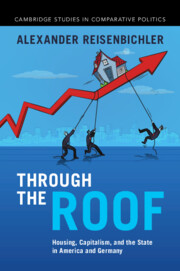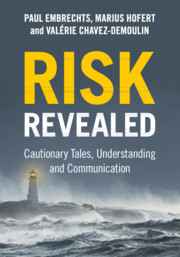Refine search
Actions for selected content:
142 results
1 - Introduction
-
- Book:
- Through the Roof
- Published online:
- 28 August 2025
- Print publication:
- 11 September 2025, pp 1-27
-
- Chapter
- Export citation

Through the Roof
- Housing, Capitalism, and the State in America and Germany
-
- Published online:
- 28 August 2025
- Print publication:
- 11 September 2025
8 - Financialised Banking and Its Discontents
-
- Book:
- Extroverted Financialisation
- Published online:
- 07 August 2025
- Print publication:
- 21 August 2025, pp 143-161
-
- Chapter
- Export citation
Chapter 1 - The Politics of Postmodern British Fiction
-
-
- Book:
- The Cambridge Companion to British Postmodern Fiction
- Published online:
- 07 August 2025
- Print publication:
- 21 August 2025, pp 18-32
-
- Chapter
- Export citation
Chapter 17 - Imagining and Occupying Wall Street
- from Part II - Histories
-
-
- Book:
- Money and American Literature
- Published online:
- 03 July 2025
- Print publication:
- 17 July 2025, pp 293-310
-
- Chapter
- Export citation
Chapter 13 - Colonial Legacies in Lebanese Financial Infrastructures and the Impact on Financial Crisis
- from Part II - Histories of Financial Infrastructures
-
-
- Book:
- The Cambridge Global Handbook of Financial Infrastructure
- Published online:
- 21 May 2025
- Print publication:
- 05 June 2025, pp 153-164
-
- Chapter
-
- You have access
- Open access
- HTML
- Export citation
Conversation 5 - Corporate Governance in the Age of Artificial Intelligence
-
- Book:
- Legal Innovation
- Published online:
- 06 February 2025
- Print publication:
- 13 February 2025, pp 119-145
-
- Chapter
-
- You have access
- Open access
- HTML
- Export citation
6 - Epilogue
-
- Book:
- Capital in Banking
- Published online:
- 09 December 2024
- Print publication:
- 23 January 2025, pp 178-184
-
- Chapter
-
- You have access
- Open access
- HTML
- Export citation
3 - Preparing for Crisis (May 11–May 19)
-
- Book:
- There Will Be the Devil to Pay
- Published online:
- 21 December 2024
- Print publication:
- 09 January 2025, pp 47-65
-
- Chapter
- Export citation
1 - Introduction
-
- Book:
- There Will Be the Devil to Pay
- Published online:
- 21 December 2024
- Print publication:
- 09 January 2025, pp 1-21
-
- Chapter
- Export citation
1 - The Beginning of the Bank Restriction Period
-
- Book:
- The Age of Paper
- Published online:
- 19 December 2024
- Print publication:
- 02 January 2025, pp 28-66
-
- Chapter
- Export citation
7 - East Asian Money
- from Part III - East Asia since 1945
-
- Book:
- East Asian International Relations
- Published online:
- 28 November 2024
- Print publication:
- 19 December 2024, pp 190-219
-
- Chapter
- Export citation
Off-track monetary policy and housing
-
- Journal:
- Macroeconomic Dynamics / Volume 29 / 2025
- Published online by Cambridge University Press:
- 27 November 2024, e60
-
- Article
- Export citation
La crise financière de 2008 et les relations de travail dans le transport aérien : le cas d’Air Canada
-
- Journal:
- Canadian Journal of Law & Society / La Revue Canadienne Droit et Société / Volume 39 / Issue 2 / August 2024
- Published online by Cambridge University Press:
- 21 October 2024, pp. 225-244
-
- Article
-
- You have access
- Open access
- HTML
- Export citation
Contemporary Financial Nationalism in Theory and Practice
-
- Journal:
- Nationalities Papers / Volume 53 / Issue 2 / March 2025
- Published online by Cambridge University Press:
- 13 May 2024, pp. 260-278
-
- Article
-
- You have access
- Open access
- HTML
- Export citation

Risk Revealed
- Cautionary Tales, Understanding and Communication
-
- Published online:
- 05 April 2024
- Print publication:
- 11 April 2024
The Global Financial Crisis – risk transfer, insurance layers, and (lack of?) reinsurance culture
-
- Journal:
- British Actuarial Journal / Volume 28 / 2023
- Published online by Cambridge University Press:
- 12 December 2023, e10
-
- Article
-
- You have access
- Open access
- HTML
- Export citation
4 - Interlude: Cultivating Financial Crisis under Aurangzeb, 1660s–1719
-
- Book:
- Bankrolling Empire
- Published online:
- 16 November 2023
- Print publication:
- 30 November 2023, pp 136-176
-
- Chapter
- Export citation
5 - COVID-19, Digital Finance, and Existential Sustainability Crises
- from Part I - Digital Transformation of Finance and Regulation
-
- Book:
- FinTech
- Published online:
- 09 November 2023
- Print publication:
- 23 November 2023, pp 58-72
-
- Chapter
- Export citation
10 - On Bubbles and Bubbling: The Idea of ‘The South Sea Bubble’
- from Part II - Case Studies in the Digital History of Ideas
-
-
- Book:
- Explorations in the Digital History of Ideas
- Published online:
- 09 November 2023
- Print publication:
- 23 November 2023, pp 206-224
-
- Chapter
- Export citation
